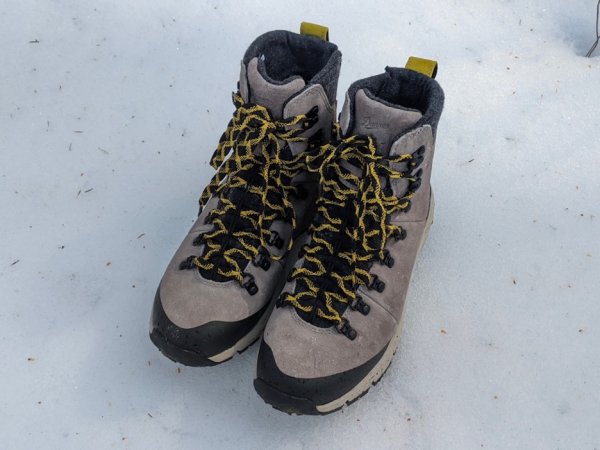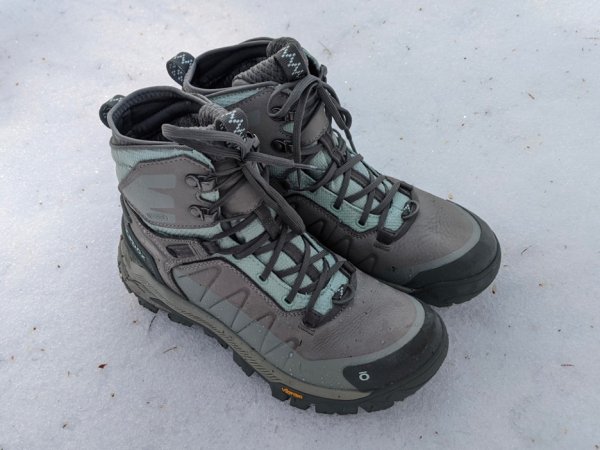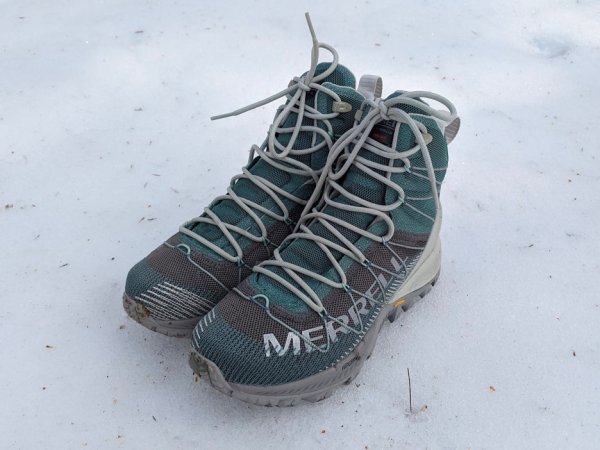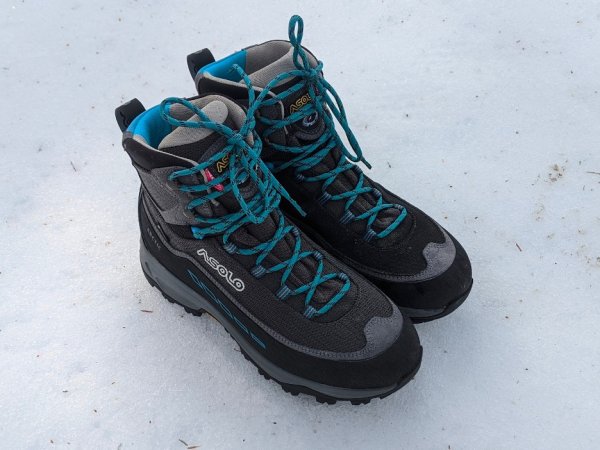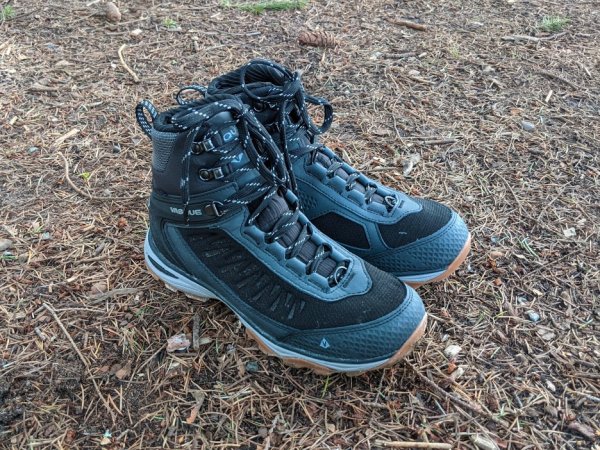We may earn revenue from the products available on this page and participate in affiliate programs. Learn More ›
You don’t want to get cold feet before a big event … and you don’t want to get cold feet going about your life when the temperature drops. So, we found answers to an essential footwear inquiry: What are the best winter boots for women? The ones that can keep feet warm in the bitter doldrums of mid-February? Not slip on ice? Not weigh you down?
Here we lay out the best women’s winter boots for every type of wearer and why we chose them—digging into the features to consider, and what you can and cannot ignore, in making your selection. Whether you’re looking for waterproof boots, women’s boots for snow and ice, the warmest snow boots, the best budget winter boots, or the best winter boots for walking, we have some suggestions.
- Best Overall: Danner Arctic 600
- Best Value: Oboz Bangtail
- Best Lightweight: Merrell Thermo Rogue
- Best for Bluebird Days: Asolo Arctic
- Best Budget: Vasque Coldspark
- Best Minimalist: Xero Shoes Alpine
How the Best Winter Boots for Women Were Tested
The best winter boots for women were tested as part of Outdoor Life’s review of the best winter hiking boots, which provides additional detail on the testing protocol that was utilized.
The Best Winter Hiking Boots: Reviews and Recommendations
Best Overall: Danner Arctic 600
Key Features
- Sizes: Men’s 7-14 (wide available); women’s 5-11
- Outsole: Vibram Nisqually Arctic Grip
- Insulation: 200g Primaloft Gold
- Danner Dry liner
Pros
- Best traction on ice in my test
- Very warm
- Side zip allows for easy on and off
Cons
- Side zip represents a point of failure
The Danner Arctic 600 performed exceptionally well on every test I threw at it. The Vibram Arctic Grip outsole (in combination with this shoe’s lug design) was extremely impressive. The stickiness of the traction meant I could barely tell I was walking on ice—it was almost impossible to slip with these shoes. Similarly this shoe stayed warmer than every other boot in my test while standing in the early spring runoff of the Middle Fork of the Snoqualmie River, and no moisture made its way into the boot. I did note, however, that this otherwise weatherproof boot was the coldest at the side zipper.

The Danner Arctic 600’s side zipper was an unusual feature among the boots that I tried. While putting on and taking off boots seemingly every fifteen minutes, I appreciated that I could put on and remove these shoes without having to untie and retie the laces.

While zippers may make things easier with a casual winter boot, zippers represent a significant failure point on just about any piece of gear—and that goes double for waterproof zippers like those on the Arctic 600. If you are concerned about the long-term durability of the zipper (and I would be), consider not using this feature on a day-to-day basis.
Best Value: Oboz Bangtail
Key Features
- Sizes: Men’s 8-14; Women’s 5-12
- Outsole: Vibram Arctic Grip
- Insulation: 200g Primaloft BIO
- B-Dry waterproof membrane
Pros
- Great traction
- Very warm
- Waterproof
Cons
- Just barely outperformed by the Danner Arctic 600
During testing, the Danner Arctic 600 and the Oboz Bangtail were neck and neck. Both used a variation of the best-in-class Vibram Arctic Grip outsole, and thus both had excellent traction on ice—but the Arctic 600 just squeaked ahead. Then, when I was testing the warmth of these insulated hiking boots, I had to run a separate test just to compare these two shoes side by side, with, again the Arctic 600 just ahead. It was almost too close to call.


But there are lots of reasons to choose the Oboz Bangtail over the Danner Arctic 600. First off, it’s less expensive for the same quality, which makes a difference with pricey boots. Next, it has better protection. The extra padding at the upper and a more robust bumper at the toe, while still weighing about the same as the Danner Arctic 600. Finally, it doesn’t have a side zip, which, while convenient, represents a point of failure that most serious adventurers would be happier without.
Best Lightweight: Merrell Thermo Rogue
Key Features
- Sizes: Men’s 7-15; women’s 5-9
- Outsole: Vibram Arctic Grip All Terrain
- Insulation: 200 grams Primaloft Gold Eco Series
- GORE-TEX waterproof membrane
Pros
- Lightweight
- Good traction
Cons
- Gets cold fairly quickly when subjected to cold water
- Flexible upper provides less protection when postholing than other winter hiking boots
Everything about hiking in winter is heavier. Your pack is heavier, your clothes are heavier. And your shoes: they are a lot heavier—likely twice the weight of your warm-weather kicks. And while it’s easy to forget that your shoes are heavier when you first start hiking, the reality is that the biomechanics of your body are such that extra weight on your feet is worth as much as five times that on your back. So there’s a good reason to search out a quality lightweight winter hiking boot.
Not only was the Merrell Thermo Rogue the lightest winter hiking boot I looked at—just over two pounds for a pair, it also performed impressively during most of my testing protocol. Like the Danner Arctic 600 and the Oboz Bangtail, it sports a variation of the Vibram Arctic Grip and was pretty grippy when walking on ice. I had to step more carefully than with the other two boots, but I would be confident walking on most level icy surfaces with the Merrell Thermo Rogue. It also handled the waterproofing test admirably well, staying dry for 14 hours when left in standing water.
When I first laced up the Merrell Thermo Rogues I noticed they warmed up fast compared to the Oboz Bangtail on the brief, fast-paced hike I took them out on before the insulation test. But when I stepped into the icy cold water of the Snoqualmie River, the situation changed rapidly. In fact, my feet got so cold so quickly that I thought water was seeping in through the top of the shoe (which was not included as part of standing water test) and I ended the test earlier than planned. However, when I went to check my sock after wrapping up with the Oboz Bangtail, I found that my foot was completely dry: the Merrell Thermo Rogues had just lost its insulative powers after only a couple of minutes of standing in cold water. To confirm this, I retested the shoes, this time being sure to lace them up tightly to prevent as much water from seeping in around the laces as possible. This made a slight difference in how quickly my foot got cold, but it was still nowhere near the performance of either the Oboz Bangtail or the Danner Arctic 600.
Best for Bluebird Days: Asolo Arctic
Key Features
- Sizes: Men’s 8-12; Women’s 6-9
- Outsole: Vibram Ghiaccio with Arctic Grip Compound
- Insulation: Gore-Tex Insulated Comfort Footwear
- Also features water-resistant suede
Pros
- Includes RECCO Rescue System Technology
- Resoleable
- Warmest boot in my test when dry
Cons
- Not fully waterproof
- Less grippy on ice than other boots in my test
- Expensive
The Asolo Arctic was easily one of the best winter hiking boots I looked at, except for one pretty serious Achilles heel: it’s not fully waterproof. It is, however, extremely water resistant. It was only slightly damp on the inside after 14 hours in standing water, and during the insulation test it took about six minutes for the cold water of the Snoqualmie River to make its way into the boot. Until that point, the Arctic Asolo was arguably the warmest boot I had tested, but after that? Game over. So if you live in a dry climate—looking at you Coloradans—then this is an excellent choice for all those bluebird days.

Those adventurers will also appreciate some of the added features of the Asolo Arctic. First off: these boots can be resoled, which significantly cuts down on your costs over time (and saves you on having to break in a new pair of winter hiking boots every few seasons). I also liked that it included RECCO Rescue System Technology, allowing professional rescuers equipped with RECCO detectors to more easily find you in the case of an SAR event.
Read Next: Best Avalanche Shovels

While the outsole of the Asolo Arctic does contain some of the Vibram Arctic Grip compound, my experience during testing was that care will need to be taken on especially slick and icy surfaces to avoid falling.
Best Budget: Vasque Coldspark
Key Features
- Sizes: Men’s 8-12; women’s 6-9
- Outsole: Vasque Monolith with ColdHold compound
- Insulation: Retain
- UltraDry waterproofing
Pros
- Affordable
Cons
- Not waterproof
- Poor traction on icy surfaces
For plenty of people, it can be hard to justify the cost outlay of a true winter hiking boot. They are expensive—often as much as $100 more expensive than their summer counterparts—and, for most people, simply don’t get as much use. The Vasque Coldspark stood out in my test for its comparative affordability, but it’s worth looking at how it performed during testing before deciding it’s the right boot for you.
The biggest issue with this boot is that it simply isn’t waterproof enough for hiking in either rainy or slushy conditions, and it certainly isn’t waterproof enough to cross shallow streams in. During my insulation test, not only did my feet start to get cold as soon as I stepped into the cold water, they were also wet in less than two minutes.
I was also disappointed by the traction of the Vasque Coldspark on icy surfaces. While other winter hiking boots in this test provided enough grip that you could get away with leaving your YakTrax at home (at least as long as you were careful), these shoes slipped and slid across the icy surface, providing only marginally more grip than my standard hiking boots.
That all being said, these are still better for winter than most of the best hiking boots, so if you’re looking to upgrade your winter kit and want to save funds for other parts of your setup, this is an option to consider.
Best Minimalist: Xero Shoes Alpine
Key Features
- Sizes: Men’s: 6.5-15; women’s: 5-10.5
- Stack Height: 7.5mm
- Weight: 28.6 ounces for a women’s 9
- Fits true to size
Pros
- Warm enough to take out into snow conditions
- Reasonably waterproof
- Comparatively affordable
Cons
- Less flexible sole than other minimalist shoes or boots
- Not appropriate for individuals unaccustomed to minimalist shoes
During my test of the best minimalist shoes for hiking and trail running there was one option that was far and away the best for winter hiking: the Xero Shoes Alpine.

I took the Xero Shoes Alpine out on an overnight snowshoe that saw temps dip well below freezing and was impressed with how well they performed. On the trek up, my feet were completely warm in a single pair of thick ski socks, including during breaks (they did finally get a little chilly when we were eating dinner). During testing, I found that these shoes were reasonably waterproof. My feet were dry over 14 miles of snowshoeing. They’d be fine to trek through a mountain stream, I just wouldn’t stay there longer than you need to. I did note, whoever, that the textured ruff at the top of the shoe had a tendency to collect snow, which would then stick to my leg and eventually melt. While this moisture didn’t travel further down the shoe (or impact my legs, which were protected by multiple other layers), it did mean that when I tried to leave the tent for a bathroom break in the middle of the night I found that my shoes were frozen in place, and it took some elbow grease to wrench them apart enough to slip back on.
Things to Consider When Shopping for the Best Winter Boots for Women
Winter boots for women exist in abundance, turning that quick note-to-self about finally buying better winter boots into an overwhelming and readily postponed plunge into endless, competing options. Keep this mind: What matters most in your decision is when and where you’ll be wearing the boots. Here are some considerations to keep in mind.
Are Your Feet Often Cold?
Warmth is non-negotiable for any winter boot. It is, after all, a winter boot. If your feet are freezing, it hardly matters if the pair get points for style, weight, price, or any other consideration—and we’ve evaluated all of our picks accordingly. But depending on the climate where you live, the duration of time you spend out in the cold, and if you’re someone that always carts a sweater around, insulation may be the deciding factor in your choice, not just another one on the list.
Insulation is very much a question of quality, not just quantity. On the natural and synthetic sides, respectively, sheepskin (or shearling) and Thinsulate are the most common insulating materials you’ll find in boots. With sheepskin, look for quality and density, as what gets labeled as sheepskin can vary widely in insulative quality. Thinsulate warmth ratings are typically given in gram measurements, with the range approximating to 100g as taking the dog for a quick walk on a cold winter day and 1000g as trekking the Arctic tundra. While this number offers a starting place, it’s important to remember that temperature, wind, water, amount of time you’ll be wearing the boots, your circulation and metabolism, your sock choice, and the fit of the boots all impact how warm your winter snow boots will actually feel.
With this in mind, in our search for the warmest boots for women, we looked for not only top-quality insulation, but also for waterproofing and an easily customizable fit.
How Wet Will Things Get?
Second only to warmth, being waterproof is an essential quality for all-around winter boots. Snow melts, rain falls, and snow shoveling and plowing build up mountains of slush. The moment your socks or feet get wet, cold deeply sets in, is crazy uncomfortable, and if you can’t dry out and warm up, things can reach more dangerous territory. If you know you’re headed for some deep slush, you need to prepare accordingly. GORE-TEX, vulcanized rubber, polyurethane-coated fabrics, and certain treated leathers all keep boots waterproof, and which one you opt for will depend on the severity and relative wetness of circumstances you’ll be encountering. Beyond waterproof materials, the best winter boots for wet conditions will also prevent water, snow, and ice from entering the boots around the tongue, laces, or other features. They will be constructed to fend off cold if immersed in wet snow or frigid water, and they will feature solid traction to keep you steady in slippery conditions.
FAQs
The internet’s top winter boot questions, answered.
As with winter boots in general, the best winter hiking boots will vary depending on setting, but traction (including ice vs. snow) and warmth are the most essential factors to consider. Pay close attention to size, as well as manufacturer recommendations about fit and socks, because boots that are too loose will have you slipping around, and too-tight boots will hurt, cut off circulation, and make your feet cold.
Lightweight boots are the best winter boots for walking long distances. We like the Sorel Tivoli IV Tall Boots for walking in winter conditions that may vary unpredictably.
Our favorite brand for stylish winter boots is Sorel. The boots are well made with sturdy, quality materials that keep us feeling safe and prepared for the elements, but without sacrificing form for function — and with a much wider aesthetic range than other brands.
Final Thoughts on the Best Winter Boots for Women
When it comes to the best winter boots for women, warmth and waterproofing should be non-negotiables. From there, it’s a question of what matters most to you, how you will be using the boots, and the particulars of your surroundings and tendencies. Be picky about fit: You want the boots to be comfortably snug, especially with sheepskin, which works with your body’s warmth rather than layer upon layer of socks. And whether you want the best boots for ice or stylish winter boots for regular wear, the quality of the construction and the materials matters, a lot.
Related: Best Winter Boots for Men




